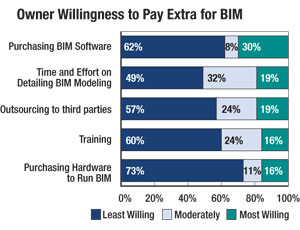The world is changing for owners of all sizes as they venture into virtual design and construction. A few years ago software developers were the ones pushing building information modeling, but owners now see themselves advocating for the tool that can lead to project collaboration. Few have even tried, much less embraced, multiparty contracts, however, where core members of the team share in project risks and rewards.


“In many ways, the owners are leading the charge. BIM is making everyone more collaborative early on,” says Charles Matta, director of federal buildings and modernization at the General Services Administration. GSA may have more BIM experience than any other owner, with different elements of BIM introduced on 70 projects from courthouses to offices.
The transformation includes owners working on everyday projects such as retail stores who cite positive results. Virtual building using BIM “has greatly improved our construction teams’ understanding of the buildings,” says John Moebes, director of construction for Crate&Barrel, Northbrook, Ill. Moebes says he has seen a “dramatic reduction in MEP/structural conflicts” and fewer delays and cost overruns “due to lack of rework to the MEP and fire-protection systems and fewer impacts to our contingency due to miscoordinated work.”
Working with BIM has changed St. Joseph Health System’s relationship with members of its construction teams for the better, says Jim Bostic, assistant vice president of construction. But there are challenges. “We are requiring architects, engineers, general contractors and subcontractors to work together where there are no clear lines of demarcation,” says Bostic. “There is a long-standing lack of respect and we have individuals with very strong personalities who are having difficulties conforming to the new paradigm that asks them to act as equals and partners with no hierarchy within the project delivery team.” St. Joseph’s, which faces California’s mandate to seismically upgrade or replace hospitals, used BIM to resolve constructability issues on a 94,000-sq-ft addition to the Mission Hospital in Mission Viejo.
“There are greater difficulties than we had foreseen,” says Daniel Okoli, director of capital planning and development at the University of Wisconsin, Madison, who has used BIM on a dozen projects over the past two years. Okoli notes “more efficient and better understanding of expectations and outcomes,” from professors to staff. But he cites resistance from firms that have been using other systems and face the sudden transition to BIM and the challenges of interoperability. “We’ve had to recognize that we cannot mandate one system” because design firms and contractors “do not just work for us,” he says.
Roy Sprague, assistant superintendent of facilities and construction for Houston’s Cypress-Fairbanks Independent School District, agrees. “One of the biggest challenges we experienced was having the team members—owner, architect and construction manager—understand and work through the technology-compatibility issues,” he says. Cypress-Fairbanks, Texas’ third-largest school district, has $1.2 billion in planned construction or projects under way and has used BIM three times.
Leaders of the Pack
Despite challenges, players “are coming to the table more willingly than in the past...with the intention to talk,” says Chuck Hardy, GSA’s deputy director for property development, chairman of the users subforum in the Associated General Contractors’ BIM Forum and board member of the Construction Users Roundtable. Hardy believes owners have to “come out with a strong voice” to drive industry change. He points to CURT white papers that have demonstrated the need for information sharing and for leveraging technology to optimize processes. The next issue is “how do we implement it?” says Hardy. “Next year the focus is going to be on the O&M side and what do we do with this information.” Hardy believes the biggest stumbling point for owners is getting people to understand and focus on the “I” in BIM, and the two-way data exchange that it is bringing.”
For GSA, facilities management is still in the pilot mode. Says GSA’s Matta, “We recognize that the impact will be considerable on data storage and collection and how to make it available to the building manager. The technology in this area is ahead of the people who will apply it.”
Tauny Woo, acting city engineer for the City of Phoenix, says planning, design and construction is about five years of a facility’s life—the remaining 45 years is O&M—so BIM is naturally a very powerful asset for facility managers. “We are still in the early stages of determining what information is needed and what information is not. I am working with our public works department facilities group to determine a criteria that we can use and eventually publish or include in future contracts,” she says. On a joint project with Arizona State University, the city used BIM to complete the Walter Cronkite School of Journalism (photo above) in 19 months from contract award to completion.
Robert A. Bank, team leader of engineering and construction for information technology systems at the U.S. Army Corps of Engineers, says the Corps does “plan to use BIM models in the O&M phase, and is working out the details.” One way the Corps will manage data is using the Construction Operations Building Information Exchange, which allows increasing amounts of data to be added to the model in a structured way by designers, contractors and product manufacturers as they move forward in project phases.
Fortunately, some owners say they will pay for at least some of these extras. In the 2008 Building Information Modeling Study conducted by McGraw-Hill Construction, owners expressed willingness to pay some of the extra costs that designers and contractors incur with the use of BIM. The study found “30% are very willing to purchase BIM software for other team members.” It also found that half of the owners surveyed “are at least moderately willing to pay extra toward the time and effort needed to model in BIM.” Owners in the survey were less likely to be willing to pay for training or for purchasing hardware to run BIM.
Owners report using a range of different contracts for BIM projects including both construction-management and design-build contracts. Crate&Barrel’s Moebes says “no way, no how” to the idea of working under a multiparty agreement, however. “The contracts are very new and don’t have any cases built around them yet,” he says. Also, the broad waiver of liability that the documents extend to the contractor and the architect appears not to be favorable to the owner when problems with the building arise later, and the tripartite agreements seem to “redistribute the reward without redistributing the risk,” Moebes adds.
Transformation
By contrast, Sutter Health, a nonprofit system of hospitals and physician groups in northern California, went through a year-long transformation from Lean Project Delivery to LPD plus a relational contract operation for the system's $1.7-billion, 455-bed Cathedral Hill project in San Francisco. Sutter’s lean coordinator, David Long, says that currently two parties out of at least three required (owner, general, architect) have signed on to the relational contract, or integrated form of agreement. “We have a joining agreement, but six to eight parties, including some subs, are still in negotiations,” says Long. “We’ve had no hang-ups of consequence so far.”
How fast is BIM spreading? Craig S. Russell, chief design and project delivery executive at Walt Disney Imagineering, says adoption of BIM tools has been “somewhat handicapped” by the confusion of many industry firms about competitive products. But adoption is “increasing at a rapid pace now” as firms settle on a suite of solutions, Russell adds. But using the tools to collaborate in an integrated project-delivery system still requires a leap of faith that it is a more efficient way to work. Disney has done a dozen projects with some level of BIM, but just this year is beginning its migration to IPD. Says Russell, “We believe the promise is great.”




Post a comment to this article
Report Abusive Comment